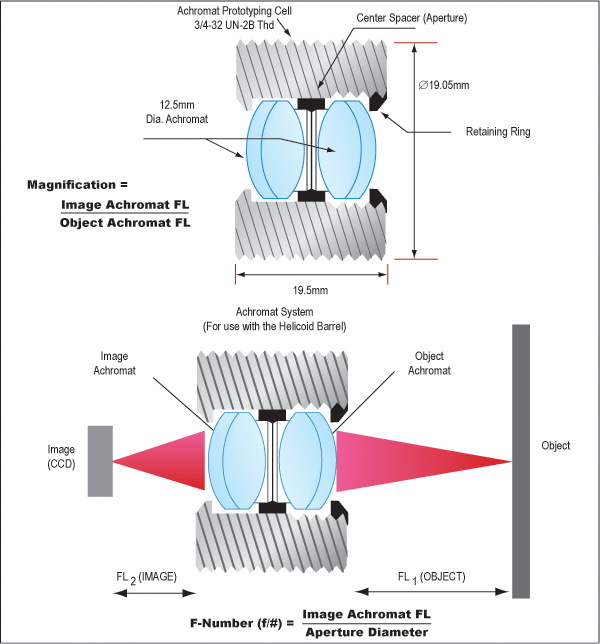
 TECHSPEC® components are designed, specified, or manufactured by Edmund Optics. Learn More
TECHSPEC® components are designed, specified, or manufactured by Edmund Optics. Learn More
A pair of achromats can offer surprising performance in imaging applications. This system enables experimentation with different focal length ratios to achieve a variety of magnifications and fields of view. The camera sensor and object should be placed at the focal length of the image and object achromat, respectively (see diagram). The f/# of the lens can be varied by using different apertures. The aperture is a center spacer that slides (no threads) into place between the achromats. Proper focusing can be attained using C-Mount spacers (coarse) and the Helicoid Barrel (fine). The Achromat Protoyping cell threads directly into the helicoid barrel and retainers are used to fix the relative position of the cell. Only 12.5mm diameter achromats can be used with this system. Achromat prototyping kit (#54-666) includes helicoid barrel, achromat prototyping cell, two retaining rings (15mm, for inside helicoid barrel) and 12.5mm achromat kit. Achromat prototyping cell (#54-719) includes the mounting cell, two retainers (for inside mounting cell) and aperture kit. Aperture kit (#54-720) contains seven apertures of 0.0 (customizable by user), 2.0, 3.0, 4.0, 6.0, 8.0, and 10.6mm diameters.
| Calculating Magnification: Table of PMAG Values [Mag = (Image Achromat F.L.) / (Object Achromat F.L.)] | |||||||||||||
| Object FL | Image Achromat Focal Length | ||||||||||||
| 14.0 | 20.0 | 25.0 | 30.0 | 35.0 | 40.0 | 45.0 | 50.0 | 60.0 | 75.0 | 80.0 | 90.0 | 100.0 | |
| 14.0 | 1.00* | 1.43 | 1.79 | 2.14 | 2.50 | 2.86 | 3.21 | 3.57 | 4.29 | 5.36 | 5.71 | 6.43 | 7.14 |
| 20.0 | 0.70* | 1.00 | 1.25 | 1.50 | 1.75 | 2.00 | 2.25 | 2.50 | 3.00 | 3.75 | 4.00 | 4.50 | 5.00 |
| 25.0 | 0.56* | 0.80 | 1.00 | 1.20 | 1.40 | 1.60 | 1.80 | 2.00 | 2.40 | 3.00 | 3.20 | 3.60 | 4.00 |
| 30.0 | 0.47* | 0.67 | 0.83 | 1.00 | 1.17 | 1.33 | 1.50 | 1.67 | 2.00 | 2.50 | 2.67 | 3.00 | 3.33 |
| 35.0 | 0.40* | 0.57 | 0.71 | 0.86 | 1.00 | 1.14 | 1.29 | 1.43 | 1.71 | 2.14 | 2.29 | 2.57 | 2.86 |
| 40.0 | 0.35* | 0.50 | 0.63 | 0.75 | 0.88 | 1.00 | 1.13 | 1.25 | 1.50 | 1.88 | 2.00 | 2.25 | 2.50 |
| 45.0 | 0.31* | 0.44 | 0.56 | 0.67 | 0.78 | 0.89 | 1.00 | 1.11 | 1.33 | 1.67 | 1.78 | 2.00 | 2.22 |
| 50.0 | 0.28* | 0.40 | 0.50 | 0.60 | 0.70 | 0.80 | 0.90 | 1.00 | 1.20 | 1.50 | 1.60 | 1.80 | 2.00 |
| 60.0 | 0.23* | 0.33 | 0.42 | 0.50 | 0.58 | 0.67 | 0.75 | 0.83 | 1.00 | 1.25 | 1.33 | 1.50 | 1.67 |
| 75.0 | 0.19* | 0.27 | 0.33 | 0.40 | 0.47 | 0.53 | 0.60 | 0.67 | 0.80 | 1.00 | 1.07 | 1.20 | 1.33 |
| 80.0 | 0.18* | 0.25 | 0.31 | 0.38 | 0.44 | 0.50 | 0.56 | 0.63 | 0.75 | 0.94 | 1.00 | 1.13 | 1.25 |
| 90.0 | 0.16* | 0.22 | 0.28 | 0.33 | 0.39 | 0.44 | 0.50 | 0.56 | 0.67 | 0.83 | 0.89 | 1.00 | 1.11 |
| 100.0 | 0.14* | 0.20 | 0.25 | 0.30 | 0.35 | 0.40 | 0.45 | 0.50 | 0.60 | 0.75 | 0.80 | 0.90 | 1.00 |
| *Image FL of 14 is not recommended for C-Mount Cameras | |||||||||||||
| Calculating the f/#: Table of f/# Values [F-Number (f/#) =( Image Achromat F.L.) / Aperture Diameter] | |||||||||||||
| Aperture Diameter | Image Achromat Focal Length | ||||||||||||
| 14.0 | 20.0 | 25.0 | 30.0 | 35.0 | 40.0 | 45.0 | 50.0 | 60.0 | 75.0 | 80.0 | 90.0 | 100.0 | |
| 10.60 | 1.32 | 1.89 | 2.36 | 2.83 | 3.30 | 3.77 | 4.25 | 4.72 | 5.66 | 7.08 | 7.55 | 8.49 | 9.43 |
| 8.00 | 1.75 | 2.50 | 3.13 | 3.75 | 4.38 | 5.00 | 5.63 | 6.25 | 7.50 | 9.38 | 10.00 | 11.25 | 12.50 |
| 6.00 | 2.33 | 3.33 | 4.17 | 5.00 | 5.83 | 6.67 | 7.50 | 8.33 | 10.00 | 12.50 | 13.33 | 15.00 | 16.67 |
| 4.00 | 3.50 | 5.00 | 6.25 | 7.50 | 8.75 | 10.00 | 11.25 | 12.50 | 15.00 | 18.75 | 20.00 | 22.50 | 25.00 |
| 3.00 | 4.67 | 6.67 | 8.33 | 10.00 | 11.67 | 13.33 | 15.00 | 16.67 | 20.00 | 25.00 | 26.67 | 30.00 | 33.33 |
| 2.00 | 7.00 | 10.00 | 12.50 | 15.00 | 17.50 | 20.00 | 22.50 | 25.00 | 30.00 | 37.50 | 40.00 | 45.00 | 50.00 |
| Application Note: Achromat pairs used at moderate f/#s (f/4 - f/8) provide good aberration correction for applications that do not require wide fields of view. | |||||||||||||
 |
|||||||||||||
1-800-363-1992
or view regional numbers
QUOTE TOOL
enter stock numbers to begin
Copyright 2025, Edmund Optics India Private Limited, #267, Greystone Building, Second Floor, 6th Cross Rd, Binnamangala, Stage 1, Indiranagar, Bengaluru, Karnataka, India 560038
California Consumer Privacy Acts (CCPA): Do Not Sell or Share My Personal Information
California Transparency in Supply Chains Act